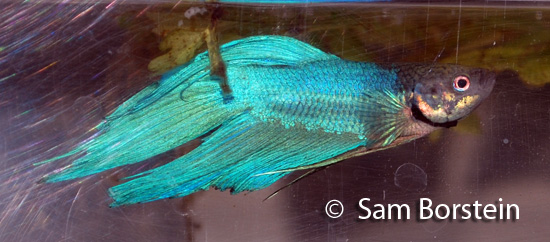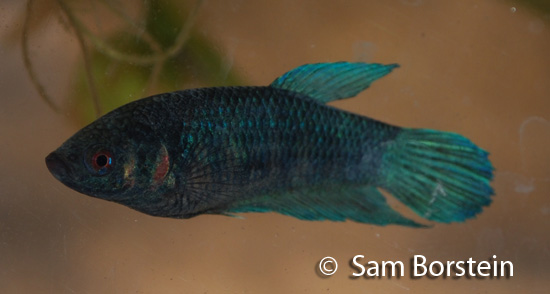Betta splendens
Regan, 1910
Siamese Fighting Fish

Above: A male Siamese Fighting Fish. Photo by Sam Borstein.
Etymology:
Genus- Betta=Native name for the fish.
Species- splendens= Radiant and shinning (Latin).
Intro:
Betta splendens, commonly known as the Siamese Fighting Fish as males, which are intolerant of each other, are used for fish fighting in Southeast Asia, is one of the most common aquarium fish in the trade. Unfortunately, this fish is commonly sold in pet shops and faulty information is given on keeping this species. Many uninformed, beginning aquarists are told that Siamese Fighting Fish can be kept in small goldfish bowls and vases and don't need a heater. This should be considered cruel as Siamese Fighting Fish are tropical fish.The fish is heavily line bred and come in all colors and finnage. Here are some of the more popular fin types:
- Standard
- Longfin
- Crowntail
Distribution:
Siamese Fighting Fish are native to Cambodia, Laos, Thailand, and Vietnam. They are typically found in floodplains and rice paddies.
Size, Maturity, and Sexual Dimorphism:
Size: Males- 3 inches, Females- 2 inches
Maturity: 1.75 inches
Sexual Dimorphism: Males are more colorful and develop more ornate finnage. Females are rounder bodied compared to males.

Above: A female Siamese Fighting Fish. Photo by Same Borstein.
Care:
Betta splendens is easy to care for. Sadly, many people believe this fish can be kept in small vases without filtration and at low temperatures. While Betta sp. are labyrinth fish and can breath atmospheric air, they do much better in a tank with filtration. Betta splendens will also do much better in a heated tank around the mid 70's°F to low 80's °F. Siamese fighting fish, although small, do much better in a tank with decorations than a vase and the behavior an activity of the fish will greatly increase.
Males of this species are known for being super aggressive with other males, fighting to the death in some instances. It is therefore not advisable to keep more than one male together. Males can also be rough on females and I don't recommend keeping a pair in a tank smaller than 10 gallons. Tanks should be decorated with wood as well as plants.
Diet:
Siamese Fighting Fish feed on insect larvae and zooplankton in the wild. In aquaria they are not fussy eater and will eat a simple flake food or small pellet. I've found occasional feedings of live food are extremely useful for conditioning females to spawn.
Breeding:
Betta splendens are easy to breed. This fish is a bubblenester and males construct a nest made of bubbles using floating plants. You should add some floating plants to the tank for the male to use to construct his nest. Some breeders use styrofoam and have luck using that instead of plants, but I prefer plants.
Males initiate spawning and entice females. The fish then embrace each other with the male biting the femles fins and wrapping around here. This cause the female to release eggs which he then fertilizes. The eggs start sinking to the bottom until the male picks them from the water column and places them in the bubblenest. Males provide parental care for the eggs guarding and tending to the bubblenest. At this point, females may face abuse from the male and should be separated.
The eggs hatch in about 24 hours depending on water temperature and the larvae remain in the nest for another 3 days. Once the fry are free swimming, parental care ceases and the male should be removed. The fry are tiny and need microfoods at the beginning of their lives. I've had success using greenwater. Once they reach a larger size you can start feeding baby brine shrimp and crushed flake. Fry grow quickly and are easy to raise.
Conclusion:
Siamese Fighting Fish are easy fish to keep and an auarium classic. Unfortunately, many of them are kept in unsuitable and less than ideal conditions. By keeping them in proper auarium conditions, the fish is a joy to watch and is easy to keep and breed. This is a good beginner fish if kept under proper conditions.
